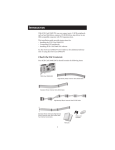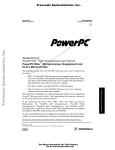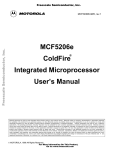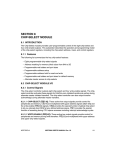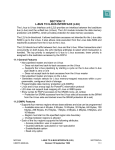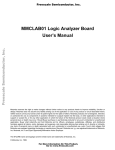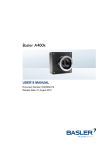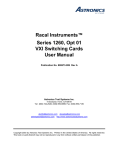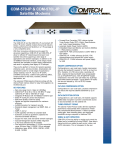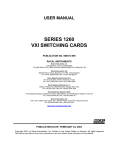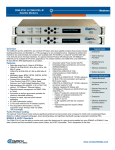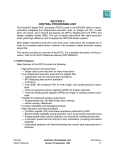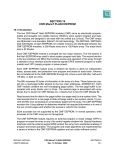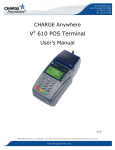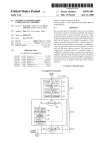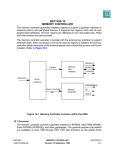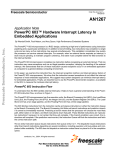Download SECTION 9 EXTERNAL BUS INTERFACE
Transcript
SECTION 9 EXTERNAL BUS INTERFACE The MPC555 bus is a synchronous, burstable bus. Signals driven on this bus are required to make the setup and hold time relative to the bus clock’s rising edge. The bus has the ability to support multiple masters. The MPC555 architecture supports byte, half-word, and word operands allowing access to 8-, 16-, and 32-bit data ports through the use of synchronous cycles controlled by the size outputs (TSIZ0, TSIZ1). For accesses to 16- and 8-bit ports, the slave must be controlled by the memory controller. 9.1 Features The external bus interface features are listed below. • 32-bit address bus with transfer size indication (only 24 available on pins) • 32-bit data bus • Bus arbitration logic on-chip supports an external master • Internal chip-select and wait state generation to support peripheral or static memory devices through the memory controller • Supports various memory (SRAM, EEPROM) types: synchronous and asynchronous, burstable and non-burstable • Supports non-wrap bursts • Flash ROM programming support • Compatible with PowerPC architecture • Easy to interface to slave devices • Bus is synchronous (all signals are referenced to rising edge of bus clock) • Bus can operate at the same frequency as the MPC555 or half the frequency. 9.2 Bus Transfer Signals The bus transfers information between the MPC555 and external memory of a peripheral device. External devices can accept or provide 8, 16, and 32 bits in parallel and must follow the handshake protocol described in this section. The maximum number of bits accepted or provided during a bus transfer is defined as the port width. The MPC555 contains an address bus that specifies the address for the transfer and a data bus that transfers the data. Control signals indicate the beginning and type of the cycle, as well as the address space and size of the transfer. The selected device then controls the length of the cycle with the signal(s) used to terminate the cycle. A strobe signal for the address bus indicates the validity of the address and provides timing information for the data. The MPC555 bus is synchronous. The bus and control input signals must be timed to setup and hold times relative to the rising edge of the clock. Bus cycles can be completed in two clock cycles. For all inputs, the MPC555 latches the level of the input during a sample window around the rising edge of the clock signal. This window is illustrated in Figure 9-1, where tsu and tho are the input setup and hold times, respectively. To ensure that an MPC555 USER’S MANUAL EXTERNAL BUS INTERFACE Rev. 15 Nov 98 MOTOROLA 9-1 input signal is recognized on a specific falling edge of the clock, that input must be stable during the sample window. If an input makes a transition during the window time period, the level recognized by the MPC555 is not predictable; however, the MPC555 always resolves the latched level to either a logic high or low before using it. In addition to meeting input setup and hold times for deterministic operation, all input signals must obey the protocols described in this section. tho tsu Clock Signal Sample Window Figure 9-1 Input Sample Window 9.3 Bus Control Signals The MPC555 initiates a bus cycle by driving the address, size, address type, cycle type, and read/write outputs. At the beginning of a bus cycle, TSIZ0 and TSIZ1 are driven with the address type signals. TSIZ0 and TSIZ1 indicate the number of bytes remaining to be transferred during an operand cycle (consisting of one or more bus cycles). These signals are valid at the rising edge of the clock in which the transfer start (TS) signal is asserted. The read/write (RD/WR) signal determines the direction of the transfer during a bus cycle. Driven at the beginning of a bus cycle, RD/WR is valid at the rising edge of the clock in which TS is asserted. The logic level of RD/WR only changes when a write cycle is preceded by a read cycle or vice versa. The signal may remain low for consecutive write cycles. MOTOROLA 9-2 EXTERNAL BUS INTERFACE Rev. 15 Nov 98 MPC555 USER’S MANUAL 32 1 1 2 4 1 ADDR[0:31] RD/WR BURST TSIZ[0:1] PTR 1 STS (BI) 1 BDIP 1 TS 1 RSV 1 1 32 1 1 1 1 1 1 1 Address and Transfer Attributes AT[0:3] KR CR Transfer Start Reservation Protocol DATA[0:31] Data RETRY BI (STS) TA TEA Transfer Cycle Termination BR BG Arbitration BB Figure 9-2 MPC555 Bus Signals 9.4 Bus Interface Signal Descriptions Table 5-1 diatribes each signal in the bus interface unit. More detailed descriptions can be found in subsequent subsections. MPC555 USER’S MANUAL EXTERNAL BUS INTERFACE Rev. 15 Nov 98 MOTOROLA 9-3 . Table 9-1 MPC555 SIU Signals Signal Name Pins Active I/O Description Address and Transfer Attributes ADDR[0:31] Address bus 24 (8:31) High O Specifies the physical address of the bus transaction. I Driven by an external bus master when it owns the external bus. Only for testing purposes. O Driven by the MPC555 along with the address when it owns the external bus. Driven high indicates that a read access is in progress. Driven low indicates that a write access is in progress. I Driven by an external master when it owns the external bus. Driven high indicates that a read access is in progress. Driven low indicates that a write access is in progress. O Driven by the MPC555 along with the address when it owns the external bus. Driven low indicates that a burst transfer is in progress. Driven high indicates that the current transfer is not a burst. I Driven by an external master when it owns the external bus. Driven low indicates that a burst transfer is in progress. Driven high indicates that the current transfer is not a burst. The MPC555 does not support burst accesses to internal slaves. O Driven by the MPC555 along with the address when it owns the external bus. Specifies the data transfer size for the transaction. I Driven by an external master when it owns the external bus. Specifies the data transfer size for the transaction. O Driven by the MPC555 along with the address when it owns the external bus. Indicates additional information about the address on the current transaction. I Only for testing purposes. O Driven by the MPC555 along with the address when it owns the external bus. Indicates additional information about the address on the current transaction. I Only for testing purposes. O Driven by the MPC555 along with the address when it owns the external bus. Indicates additional information about the address on the current transaction. I Only for testing purposes. I In the case of regular transaction, this signal is driven by the slave device to indicate that the MPC555 must relinquish the ownership of the bus and retry the cycle. O When an external master owns the bus and the internal MPC555 bus initiates access to the external bus at the same time, this signal is used to cause the external master to relinquish the bus for one clock to solve the contention. RD/WR 1 HIgh Read/write BURST 1 Low Burst transfer TSIZ[0:1] 2 High Transfer size AT[0:3] 3 High Address type RSV 1 Low Reservation transfer PTR 1 High Program trace RETRY MOTOROLA 9-4 1 Low EXTERNAL BUS INTERFACE Rev. 15 Nov 98 MPC555 USER’S MANUAL Table 9-1 MPC555 SIU Signals (Continued) Signal Name Pins Active I/O Description O Driven by the MPC555 when it owns the external bus. It is part of the burst protocol. When BDIP is asserted, the second beat in front of the current one is requested by the master. This signal is negated prior to the end of a burst to terminate the burst data phase early. I Driven by an external master when it owns the external bus. When BDIP is asserted, the second beat in front of the current one is requested by the master. This signal is negated prior to the end of a burst to terminate the burst data phase early. The MPC555 does not support burst accesses to internal slaves. BDIP 1 Low Burst data in progress Transfer Start O Driven by the MPC555 when it owns the external bus. Indicates the start of a transaction on the external bus. I Driven by an external master when it owns the external bus. It indicates the start of a transaction on the external bus or (in show cycle mode) signals the beginning of an internal transaction. O Driven by the MPC555 when it owns the external bus. Indicates the start of a transaction on the external bus or signals the beginning of an internal transaction in show cycle mode. TS 1 Low Transfer start STS 1 Low Special transfer start Reservation Protocol I Each PowerPC CPU has its own CR signal. Assertion of CR instructs the bus master to clear its reservation; some other master has touched its reserved space. This is a pulsed signal. I In case of a bus cycle initiated by a STWCX instruction issued by the RCPU to a non-local bus on which the storage reservation has been lost, this signal is used by the non-local bus interface to backoff the cycle. Refer to 9.5.9 Storage Reservation for details. CR 1 Low Cancel reservation KR 1 Kill reservation MPC555 USER’S MANUAL Low EXTERNAL BUS INTERFACE Rev. 15 Nov 98 MOTOROLA 9-5 Table 9-1 MPC555 SIU Signals (Continued) Signal Name Pins Active I/O Description Data The data bus has the following byte lane assignments: Data Byte Byte Lane DATA[0:7] 0 DATA[8:15] 1 DATA[16:23] 2 DATA[24:31] 3 DATA[0:31] 32 High O Data bus Driven by the MPC555 when it owns the external bus and it initiated a write transaction to a slave device. For single beat transactions, the byte lanes not selected for the transfer by ADDR[30:31] and TSIZ[0:1] do not supply valid data. In addition, the MPC555 drives DATA[0:31] when an external master owns the external bus and initiated a read transaction to an internal slave module. I Driven by the slave in a read transaction. For single beat transactions, the MPC555 does not sample byte lanes that are not selected for the transfer by ADDR[30:31] and TSIZ[0:1]. In addition, an external master that owns the bus and initiated a write transaction to an internal slave module drives DATA[0:31]. Transfer Cycle Termination I Driven by the slave device to which the current transaction was addressed. Indicates that the slave has received the data on the write cycle or returned data on the read cycle. If the transaction is a burst, TA should be asserted for each one of the transaction beats. O Driven by the MPC555 when the slave device is controlled by the on-chip memory controller or when an external master initiated a transaction to an internal slave module. I Driven by the slave device to which the current transaction was addressed. Indicates that an error condition has occurred during the bus cycle. O Driven by the MPC555 when the internal bus monitor detected an erroneous bus condition, or when an external master initiated a transaction to an internal slave module and an internal error was detected. I Driven by the slave device to which the current transaction was addressed. Indicates that the current slave does not support burst mode. O Driven by the MPC555 when the slave device is controlled by the on-chip memory controller. the MPC555 also asserts BI for any external master burst access to internal MPC555 memory space. TA 1 LOW Transfer acknowledge TEA Transfer error acknowledge 1 Low BI 1 Burst inhibit MOTOROLA 9-6 Low EXTERNAL BUS INTERFACE Rev. 15 Nov 98 MPC555 USER’S MANUAL Table 9-1 MPC555 SIU Signals (Continued) Signal Name Pins Active I/O Description ARBITRATION BR 1 I When the internal arbiter is enabled, BR assertion indicates that an external master is requesting the bus. O Driven by the MPC555 when the internal arbiter is disabled and the chip is not parked. Low Bus request O BG 1 Low Bus grant When the internal arbiter is enabled, the MPC555 asserts this signal to indicate that an external master may assume ownership of the bus and begin a bus transaction. The BG signal should be qualified by the master requesting the bus in order to ensure it is the bus owner: Qualified bus grant = BG & ~ BB I When the internal arbiter is disabled, BG is sampled and properly qualified by the MPC555 when an external bus transaction is to be executed by the chip. When the internal arbiter is enabled, the MPC555 asserts this signal to indicate that it is the current owner of the bus. O BB 1 Low Bus busy I When the internal arbiter is disabled, the MPC555 asserts this signal after the external arbiter has granted the ownership of the bus to the chip and it is ready to start the transaction. When the internal arbiter is enabled, the MPC555 samples this signal to get indication of when the external master ended its bus tenure (BB negated). When the internal arbiter is disabled, the BB is sampled to properly qualify the BG line when an external bus transaction is to be executed by the chip. 9.5 Bus Operations This section provides a functional description of the system bus, the signals that control it, and the bus cycles provided for data transfer operations. It also describes the error conditions, bus arbitration, and reset operation. The MPC555 generates a system clock output (CLKOUT). This output sets the frequency of operation for the bus interface directly. Internally, the MPC555 uses a phase-lock loop (PLL) circuit to generate a master clock for all of the CPU circuitry (including the bus interface) which is phase-locked to the CLKOUT output signal. All signals for the MPC555 bus interface are specified with respect to the rising edge of the external CLKOUT and are guaranteed to be sampled as inputs or changed as outputs with respect to that edge. Since the same clock edge is referenced for driving or sampling the bus signals, the possibility of clock skew could exist between various modules in a system due to routing or the use of multiple clock lines. It is the responsibility of the system to handle any such clock skew problems that could occur. MPC555 USER’S MANUAL EXTERNAL BUS INTERFACE Rev. 15 Nov 98 MOTOROLA 9-7 9.5.1 Basic Transfer Protocol The basic transfer protocol defines the sequence of actions that must occur on the MPC555 bus to perform a complete bus transaction. A simplified scheme of the basic transfer protocol is illustrated in Figure 9-3. Arbitration Address Transfer Data Transfer Termination Figure 9-3 Basic Transfer Protocol The basic transfer protocol provides for an arbitration phase and an address and data transfer phase. The address phase specifies the address for the transaction and the transfer attributes that describe the transaction. The data phase performs the transfer of data (if any is to be transferred). The data phase may transfer a single beat of data (4 bytes or less) for nonburst operations, a 4-beat burst of data (4 x 4 bytes), an 8-beat burst of data (8 x 2 bytes) or a 16-beat burst of data (16 x 1 bytes). 9.5.2 Single Beat Transfer During the data transfer phase, the data is transferred from master to slave (in write cycles) or from slave to master (on read cycles). During a write cycle, the master drives the data as soon as it can, but never earlier than the cycle following the address transfer phase. The master has to take into consideration the “one dead clock cycle” switching between drivers to avoid electrical contentions. The master can stop driving the data bus as soon as it samples the TA line asserted on the rising edge of the CLKOUT. During a read cycle, the master accepts the data bus contents as valid at the rising edge of the CLKOUT in which the TA signal is sampled/asserted. 9.5.2.1 Single Beat Read Flow The basic read cycle begins with a bus arbitration, followed by the address transfer, then the data transfer. The handshakes are illustrated in the following flow and timing diagrams as applicable to the fixed transaction protocol. MOTOROLA 9-8 EXTERNAL BUS INTERFACE Rev. 15 Nov 98 MPC555 USER’S MANUAL Master Slave Request bus (BR) Receive bus grant (BG) from arbiter Assert bus busy (BB) if no other master is driving bus Assert transfer start (TS) Drive address and attributes Receive address Return data Assert transfer acknowledge (TA) Receive data Figure 9-4 Basic Flow Diagram of a Single Beat Read Cycle MPC555 USER’S MANUAL EXTERNAL BUS INTERFACE Rev. 15 Nov 98 MOTOROLA 9-9 CLKOUT BR BG Receive bus grant and bus busy negated O O Assert BB, drive address and assert TS BB O ADDR[0:31] RD/WR TSIZ[0:1] BURST, BDIP TS O Data TA O Data is valid Figure 9-5 Single Beat Read Cycle–Basic Timing–Zero Wait States MOTOROLA 9-10 EXTERNAL BUS INTERFACE Rev. 15 Nov 98 MPC555 USER’S MANUAL CLKOUT BR BG Receive bus grant and bus busy negated O O assert BB, drive address and assert TS BB O ADDR[0:31] RD/WR TSIZ[0:1] BURST, BDIP TS O Data TA Wait state O Data is valid Figure 9-6 Single Beat Read Cycle–Basic Timing–One Wait State 9.5.2.2 Single Beat Write Flow The basic write cycle begins with a bus arbitration, followed by the address transfer, then the data transfer. The handshakes are illustrated in the following flow and timing diagrams as applicable to the fixed transaction protocol. MPC555 USER’S MANUAL EXTERNAL BUS INTERFACE Rev. 15 Nov 98 MOTOROLA 9-11 Master Slave Request bus (BR) Receive bus grant (BG) from arbiter Assert bus busy (BB) if no other master is driving bus Assert transfer start (TS) Drive address and attributes Drive data Assert transfer acknowledge (TA) Interrupt data driving Figure 9-7 Basic Flow Diagram of a Single Beat Write Cycle MOTOROLA 9-12 EXTERNAL BUS INTERFACE Rev. 15 Nov 98 MPC555 USER’S MANUAL CLKOUT BR BG Receive bus grant and bus busy negated O O Assert BB, drive address and assert TS BB O ADDR[0:31] RD/WR TSIZ[0:1] BURST, BDIP TS O Data TA O Data is sampled Figure 9-8 Single Beat Basic Write Cycle Timing, Zero Wait States MPC555 USER’S MANUAL EXTERNAL BUS INTERFACE Rev. 15 Nov 98 MOTOROLA 9-13 CLKOUT BR Receive bus grant and bus busy negated BG O O Assert BB, drive address and assert TS BB O ADDR[0:31] RD/WR TSIZ[0:1] BURST, BDIP TS O Data TA Wait state O Data is sampled Figure 9-9 Single Beat Basic Write Cycle Timing, One Wait State 9.5.2.3 Single Beat Flow with Small Port Size The general case of single beat transfers assumes that the external memory has a 32bit port size. The MPC555 provides an effective mechanism for interfacing with 16-bit and 8-bit port size memories, allowing transfers to these devices when they are controlled by the internal memory controller. In this case, the MPC555 attempts to initiate a transfer as in the normal case. If the bus interface receives a small port size (16 or 8 bits) indication before the transfer acknowledge to the first beat (through the internal memory controller), the MCU initiates successive transactions until the completion of the data transfer. Note that all the transactions initiated to complete the data transfer are considered to be part of an atomic transaction, so the MCU does not allow other unrelated master accesses or MOTOROLA 9-14 EXTERNAL BUS INTERFACE Rev. 15 Nov 98 MPC555 USER’S MANUAL bus arbitration to intervene between the transfers. If any of the transactions except the first is re-tried during an access to a small port, then an exception is generated to the RCPU. CLKOUT BR BG BB ADDR[0:1] ADDR + 2 ADDR RD/WR TSIZ[0:1] 10 00 BURST, BDIP TS STS Data ABCDEFGH EFGHEFGH TA Figure 9-10 Single Beat 32-Bit Data Write Cycle Timing, 16 Bit-Port Size 9.5.3 Burst Transfer The MPC555 uses non-wrapping burst transfers to access operands of up to 16 bytes (four words). A non-wrapping burst access stops accessing the external device when the word address is modulo four. The MPC555 begins the access by supplying a starting address that points to one of the words and requiring the memory device to sequentially drive or sample each word on the data bus. The selected slave device MPC555 USER’S MANUAL EXTERNAL BUS INTERFACE Rev. 15 Nov 98 MOTOROLA 9-15 must internally increment ADDR28 and ADDR29 (and ADDR30 in the case of a 16-bit port slave device, and also ADDR31 in the case of an 8-bit port slave device) of the supplied address for each transfer, causing the address to reach a four-word boundary, and then stop. The address and transfer attributes supplied by the MPC555 remain stable during the transfers. The selected device terminates each transfer by driving or sampling the word on the data bus and asserting TA. The MPC555 also supports burst-inhibited transfers for slave devices that are unable to support bursting. For this type of bus cycle, the selected slave device supplies or samples the first word the MPC555 points to and asserts the burst-inhibit signal with TA for the first transfer of the burst access. The MPC555 responds by terminating the burst and accessing the remainder of the 16-byte block. These remaining accesses use up to three read/write bus cycles (each one for a word) in the case of a 32-bit port width slave, up to seven read/write bus cycles in the case of a 16-bit port width slave, or up to fifteen read/write bus cycles in the case of a 8-bit port width slave. The general case of burst transfers assumes that the external memory has a 32-bit port size. The MPC555 provides an effective mechanism for interfacing with 16-bit port size memories and 8-bit port size memories allowing bursts transfers to these devices when they are controlled by the internal memory controller. In this case, the MPC555 attempts to initiate a burst transfer as in the normal case. If the memory controller signals to the bus interface that the external device has a small port size (8 or 16 bits), and if the burst is accepted, the bus interface completes a burst of 8 or 16 beats. Each of the data beats of the burst transfers effectively only one or two bytes. Note that this burst of 8 or 16 beats is considered an atomic transaction, so the MPC555 does not allow other unrelated master accesses or bus arbitration to intervene between the transfers. 9.5.4 Burst Mechanism In addition to the standard bus signals, the MPC555 burst mechanism uses the following signals: • The BURST signal indicates that the cycle is a burst cycle. • The burst data in progress (BDIP) signal indicates the duration of the burst data. • The burst inhibit (BI) signal indicates whether the slave is burstable. At the start of the burst transfer, the master drives the address, the address attributes, and the BURST signal to indicate that a burst transfer is being initiated, and asserts TS. If the slave is burstable, it negates the burst-inhibit (BI) signal. If the slave cannot burst, it asserts BI. During the data phase of a burst write cycle the master drives the data. It also asserts BDIP if it intends to drive the data beat following the current data beat. When the slave has received the data, it asserts the signal transfer acknowledge to indicate to the master that it is ready for the next data transfer. The master again drives the next data and asserts or negates the BDIP signal. If the master does not intend to drive another MOTOROLA 9-16 EXTERNAL BUS INTERFACE Rev. 15 Nov 98 MPC555 USER’S MANUAL data beat following the current one, it negates BDIP to indicate to the slave that the next data beat transfer is the last data of the burst write transfer. BDIP has two basic timings: normal and late (see Figure 9-13 and Figure 9-14). In the late timing mode, assertion of BDIP is delayed by the number of wait states in the first data beat. This implies that for zero-wait-state cycles, BDIP assertion time is identical in normal and late modes. Cycles with late BDIP generation can occur only during cycles for which the memory controller generates TA internally. Refer to SECTION 10 MEMORY CONTROLLER for more information. In the MPC555, no internal master initiates write bursts. The MPC555 is designed to perform this kind of transaction in order to support an external master that is using the memory controller services. Refer to 10.7 Memory Controller External Master Support. During the data phase of a burst read cycle, the master receives data from the addressed slave. If the master needs more than one data beat, it asserts BDIP. Upon receiving the second-to-last data beat, the master negates BDIP. The slave stops driving new data after it receives the negation of the BDIP signal at the rising edge of the clock. MPC555 USER’S MANUAL EXTERNAL BUS INTERFACE Rev. 15 Nov 98 MOTOROLA 9-17 Master Slave Request Bus (BR) Receive bus grant (BG) from arbiter Assert Bus Busy (BB) if No Other Master is Driving Assert Transfer Start (TS) Drive Address and Attributes Drive BURST Asserted Receive Address ADDR[28:29] mod 4 = ? =0 Assert BDIP Return Data Assert Transfer Acknowledge (TA) Receive Data BDIP Asserted =1 No Drive Last Data & Assert TA Yes Return Data Assert Transfer Acknowledge (TA) Assert BDIP Receive Data BDIP Asserted =2 Drive Last Data & Assert TA No Yes Assert BDIP Return Data Assert Transfer Acknowledge (TA) Receive Data BDIP Asserted No Drive Last Data & Assert TA =3 Yes Negate Burst Data in Progress (BDIP) Return Data Assert Transfer Acknowledge (TA) BDIP Asserted Receive Sata No Drive Last Data & Assert TA Yes Figure 9-11 Basic Flow Diagram Of A Burst Read Cycle MOTOROLA 9-18 EXTERNAL BUS INTERFACE Rev. 15 Nov 98 MPC555 USER’S MANUAL CLKOUT BR BG BB ADDR[0:31] ADDR[28:31] = 0000 RD/WR TSIZ[0:1] 00 BURST TS Last Beat O Expects Another Data BDIP O O O Data TA O O Data is Valid O Data is Valid O Data is Valid Data is Valid Figure 9-12 Burst-Read Cycle–32-Bit Port Size–Zero Wait State MPC555 USER’S MANUAL EXTERNAL BUS INTERFACE Rev. 15 Nov 98 MOTOROLA 9-19 CLKOUT BR BG BB ADDR[0:31] ADDR[28:31] = 0000 RD/WR TSIZ[0:1] 00 BURST TS Last Beat O Expects Another Data BDIP Normal Late O O O Data TA O Wait State O Data is Valid O Data is Valid O Data is Valid Data is Valid Figure 9-13 Burst-Read Cycle–32-Bit Port Size–One Wait State MOTOROLA 9-20 EXTERNAL BUS INTERFACE Rev. 15 Nov 98 MPC555 USER’S MANUAL CLKOUT BR BG BB ADDR[0:31] ADDR[28:31] = 0000 RD/WR TSIZ[0:1] 00 BURST TS Last Beat BDIP Normal or Late O Expects Another Data O O O O O Data TA Data is Valid O Data is Valid O Data is Valid Data is Valid Wait State Figure 9-14 Burst-Read Cycle–32-Bit Port Size–Wait States Between Beats MPC555 USER’S MANUAL EXTERNAL BUS INTERFACE Rev. 15 Nov 98 MOTOROLA 9-21 CLKOUT BR BG BB ADDR[0:31] ADDR[28:31] = 0000 RD/WR TSIZ[0:1] 00 BURST TS BDIP Data[0:15] TA Figure 9-15 Burst-Read Cycle, 16-Bit Port Size MOTOROLA 9-22 EXTERNAL BUS INTERFACE Rev. 15 Nov 98 MPC555 USER’S MANUAL Master Slave Request Bus (BR) Receive Bus Grant (BG) from Arbiter Assert Bus Busy (BB) if No Other Master is Driving Assert Transfer Start (TS) Drive Address and Attributes Drive BURST Asserted Drive data Receive Address ADDR[28:29] mod 4 = ? =0 Assert BDIP Sample Data Assert Transfer Acknowledge (TA) Drive Data BDIP Asserted =1 No Don’t Sample Next Data Yes Sample Data Assert Transfer Acknowledge (TA) Assert BDIP Drive Data BDIP Asserted =2 No Don’t Sample Next Data No Don’t Sample Next Data Yes Assert BDIP Sample Data Assert Transfer Acknowledge (TA) Drive Data BDIP Asserted =3 Yes Negate Burst Data in Progress (BDIP) Sample Data Assert Transfer Acknowledge (TA) BDIP Asserted Stop Driving Data No Don’t Sample Next Data Yes Figure 9-16 Basic Flow Diagram of a Burst Write Cycle MPC555 USER’S MANUAL EXTERNAL BUS INTERFACE Rev. 15 Nov 98 MOTOROLA 9-23 CLKOUT BR BG BB ADDR[0:31] ADDR[28:29] = 00 RD/WR TSIZ[0:1] 00 BURST TS Last Beat O Will Drive Another Data BDIP O O O O O O Data TA O Data Data Data is Sampled is Sampled is Sampled Data is Sampled Figure 9-17 Burst-Write Cycle, 32-Bit Port Size, Zero Wait States MOTOROLA 9-24 EXTERNAL BUS INTERFACE Rev. 15 Nov 98 MPC555 USER’S MANUAL CLKOUT BR BG BB ADDR[0:27] ADDR[28:29] 0 1 2 3 ADDR[30:31] RD/WR TSIZ[0:1] 00 BURST* TS BDIP* Data TA BI * BURST and BDIP will be asserted for one cycle if the RCPU core requests a burst, but the USIU splits it into a sequence of normal cycles. Figure 9-18 Burst-Inhibit Cycle, 32-Bit Port Size (Emulated Burst) MPC555 USER’S MANUAL EXTERNAL BUS INTERFACE Rev. 15 Nov 98 MOTOROLA 9-25 CLKOUT BR BG BB ADDR(0:29) n (n modulo 4 = 1) ADDR[30:31] RD/WR TSIZ[0:1] 00 BURST TS Expects Another Data BDIP O O Data TA BI Figure 9-19 Non-Wrap Burst with Three Beats MOTOROLA 9-26 EXTERNAL BUS INTERFACE Rev. 15 Nov 98 MPC555 USER’S MANUAL CLKOUT BR BG BB ADDR[0:29] ADDR[30:31] n (n modulo 4 = 3) 00 RD/WR TSIZ[0:1] 00 BURST TS Is Never Asserted BDIP First and Last Beat Data TA O DATA is Sampled Figure 9—2. Non-Wrap Burst with One Data Beat MPC555 USER’S MANUAL EXTERNAL BUS INTERFACE Rev. 15 Nov 98 MOTOROLA 9-27 9.5.5 Alignment and Packaging of Transfers The MPC555 external bus requires natural address alignment: • Byte accesses allow any address alignment • Half-word accesses require address bit 31 to equal zero • Word accesses require address bits 30 – 31 to equal zero • Burst accesses require address bits 30 – 31 to equal zero The MPC555 performs operand transfers through its 32-bit data port. If the transfer is controlled by the internal memory controller, the MPC555 can support 8- and 16-bit data port sizes. The bus requires that the portion of the data bus used for a transfer to or from a particular port size be fixed. A 32-bit port must reside on DATA[0:31], a 16-bit port must reside on DATA[0:15], and an 8-bit port must reside on DATA[0:7]. The MPC555 always tries to transfer the maximum amount of data on all bus cycles. For a word operation, it always assumes that the port is 32 bits wide when beginning the bus cycle. In Figure 9-20, Figure 9-21, Table 9-3, and Table 9-4, the following conventions are used: • OP0 is the most-significant byte of a word operand and OP3 is the least-significant byte. • The two bytes of a half-word operand are either OP0 (most-significant) and OP1 or OP2 (most-significant) and OP3, depending on the address of the access. • The single byte of a byte-length operand is OP0, OP1, OP2, or OP3, depending on the address of the access. 0 31 OP0 OP1 OP0 OP1 OP2 OP3 OP2 OP3 Word Half-word OP0 OP1 Byte OP2 OP3 Figure 9-20 Internal Operand Representation Figure 9-21 illustrates the device connections on the data bus. MOTOROLA 9-28 EXTERNAL BUS INTERFACE Rev. 15 Nov 98 MPC555 USER’S MANUAL 0 31 OP0 OP1 DATA[0:7] OP2 DATA[8:15] OP0 OP1 OP0 OP1 OP2 OP3 Interface Output Register OP3 DATA[16:23] OP2 DATA[24:31] OP3 32-bit Port Size 16-bit Port Size OP0 OP1 8-bit Port Size OP2 OP3 Figure 9-21 Interface To Different Port Size Devices Table 9-3 lists the bytes required on the data bus for read cycles. MPC555 USER’S MANUAL EXTERNAL BUS INTERFACE Rev. 15 Nov 98 MOTOROLA 9-29 Table 9-3 Data Bus Requirements For Read Cycles Transfer Size TSIZE [0:1] Byte Half-word Word Address 32-bit Port Size 16-bit Port Size 8-bit Port Size ADDR [30:31] DATA [0:7] DATA [8:15] DATA [16:23] DATA [24:31] DATA [0:7] DATA [8:15] DATA [0:7] 01 00 OP0 — — — OP0 — OP0 01 01 — OP1 — — — OP1 OP1 01 10 — — OP2 — OP2 — OP2 01 11 — — — OP3 — OP3 OP3 10 00 OP0 OP1 — — OP0 OP1 OP0 10 10 — — OP2 OP3 OP2 OP3 OP2 00 00 OP0 OP1 OP2 OP3 OP0 OP1 OP0 NOTE: “—” denotes a byte not required during that read cycle. Table 9-4 lists the patterns of the data transfer for write cycles when the MPC555 initiates an access. Table 9-4 Data Bus Contents for Write Cycles Transfer Size Byte Half-word Word Address External Data Bus Pattern TSIZE[0:1] ADDR [30:31] DATA [0:7] DATA [8:15] DATA [16:23] DATA [24:31] 01 00 OP0 — — — 01 01 OP1 OP1 — — 01 10 OP2 — OP2 — 01 11 OP3 OP3 — OP3 10 00 OP0 OP1 — — 10 10 OP2 OP3 OP2 OP3 00 00 OP0 OP1 OP2 OP3 NOTE: “—” denotes a byte not driven during that write cycle. 9.5.6 Arbitration Phase The external bus design provides for a single bus master at any one time, either the MPC555 or an external device. One or more of the external devices on the bus can have the capability of becoming bus master for the external bus. Bus arbitration may be handled either by an external central bus arbiter or by the internal on-chip arbiter. In the latter case, the system is optimized for one external bus master besides the MPC555. The arbitration configuration (external or internal) is set at system reset. Each bus master must have bus request (BR), bus grant (BG), and bus busy (BB) signals. The device that needs the bus asserts BR. The device then waits for the arbiter to assert BG. In addition, the new master must look at BB to ensure that no other master is driving the bus before it can assert BB to assume ownership of the bus. Any time the arbiter has taken the bus grant away from the master and the master wants to execute a new cycle, the master must re-arbitrate before a new cycle can be executed. MOTOROLA 9-30 EXTERNAL BUS INTERFACE Rev. 15 Nov 98 MPC555 USER’S MANUAL The MPC555, however, guarantees data coherency for access to a small port size and for decomposed bursts. This means that the MPC555 will not release the bus before the completion of the transactions that are considered atomic. Figure 9-22 describes the basic protocol for bus arbitration. Requesting Device Arbiter Request the Bus 1. Assert BR GRANT Bus arbitration 1.Assert BG Acknowledge Bus Mastership 1. Wait for BB to be negated. 2. Assert BB to becom enext master Terminate Arbitration 3. Negate BR 1. Negate BG (or keep asserted to park bus master Operate as bus Master 1. Perform data transfer Release Bus Mastership 1. Negate BB Figure 9-22 Bus Arbitration Flowchart 9.5.6.1 Bus Request The potential bus master asserts BR to request bus mastership. BR should be negated as soon as the bus is granted, the bus is not busy, and the new master can drive the bus. If more requests are pending, the master can keep asserting its bus request as long as needed. When configured for external central arbitration, the MPC555 drives this signal when it requires bus mastership. When the internal on-chip arbiter is used, this signal is an input to the internal arbiter and should be driven by the external bus master. 9.5.6.2 Bus Grant The arbiter asserts BG to indicate that the bus is granted to the requesting device. This signal can be negated following the negation of BR or kept asserted for the current master to park the bus. MPC555 USER’S MANUAL EXTERNAL BUS INTERFACE Rev. 15 Nov 98 MOTOROLA 9-31 When configured for external central arbitration, BG is an input signal to the MPC555 from the external arbiter. When the internal on-chip arbiter is used, this signal is an output from the internal arbiter to the external bus master. 9.5.6.3 Bus Busy BB assertion indicates that the current bus master is using the bus. New masters should not begin transfer until this signal is negated. The bus owner should not relinquish or negate this signal until the transfer is complete. To avoid contention on the BB line, the master should three-state this signal when it gets a logical one value. This requires the connection of an external pull-up resistor to ensure that a master that acquires the bus is able to recognize the BB line negated, regardless of how many cycles have passed since the previous master relinquished the bus. Refer to Figure 9-23. Master External Bus TS MPC555 BB Slave 2 Figure 9-23 Masters Signals Basic Connection MOTOROLA 9-32 EXTERNAL BUS INTERFACE Rev. 15 Nov 98 MPC555 USER’S MANUAL CLKOUT BR0 BG0 BR1 BG1 BB ADDR & Attr. TS TA Master 0 “Turns On” and Drives Signals Master 0 Master 1 Negates BB “Turns On” and and “Turns Off” Drives Signals (Three-state Controls) Figure 9-24 Bus Arbitration Timing Diagram 9.5.6.4 Internal Bus Arbiter The MPC555 can be configured at system reset to use the internal bus arbiter. In this case, the MPC555 will be parked on the bus. The parking feature allows the MPC555 to skip the bus request phase, and if BB is negated, assert BB and initiate the transaction without waiting for BG from the arbiter. The priority of the external device relative to the internal MPC555 bus masters is programmed in the SIU module configuration register. If the external device requests the bus and the MPC555 does not require it, or if the external device has higher priority than the current internal bus master, the MPC555 grants the bus to the external device. Table 9-5 describes the priority mechanism used by the internal arbiter. MPC555 USER’S MANUAL EXTERNAL BUS INTERFACE Rev. 15 Nov 98 MOTOROLA 9-33 Table 9-5 Priority Between Internal and External Masters over External Bus1 Type Direction Priority Parked access2 Internal → external 0 Instruction access Internal → external 3 Data access Internal → external 4 External access external → external/internal EARP3 (could be programmed to 0 – 7) NOTES: 1. External master will be granted external bus ownership if EARP is greater than the internal access priority. 2. Parked access is instruction or data access from the RCPU which is initiated on the internal bus without requesting it first in order to improve performance. 3. Refer to 6.13.1.1 SIU Module Configuration Register. Figure 9-25 illustrates the internal finite-state machine that implements the arbiter protocol. MOTOROLA 9-34 EXTERNAL BUS INTERFACE Rev. 15 Nov 98 MPC555 USER’S MANUAL External Owner BG = 0 BB = t.s MPC555 Internal Master With Higher Priority than the External Device Requires the Bus 1, B R =1 BR = 0 External Master Requests Bus BB = BR = 1 Ext Master Release Bus BB = 0 IDLE MPC555 Bus Wait BG = 1 BB = t.s BG = 1 BB = t.s MCU Needs the Bus BB = 1 MPC555 No Longer Needs the Bus MPC555 Owner BR = 0 BG = 1 BB = 0 External Device With Higher Priority than the Current Internal Bus Master Requests the Bus MPC555 Still Needs the Bus Figure 9-25 Internal Bus Arbitration State Machine 9.5.7 Address Transfer Phase Signals Address transfer phase signals include the following: • Transfer start • Address bus • Transfer attributes Transfer attributes signals include RD/WR, BURST, TSIZ[0:1], AT[0:3], STS, and BDIP. With the exception of the BDIP, these signals are available at the same time as the address bus. MPC555 USER’S MANUAL EXTERNAL BUS INTERFACE Rev. 15 Nov 98 MOTOROLA 9-35 9.5.7.1 Transfer Start This signal (TS) indicates the beginning of a transaction on the bus addressing a slave device. This signal should be asserted by a master only after the ownership of the bus was granted by the arbitration protocol. This signal is asserted for the first cycle of the transaction only and is negated in successive clock cycles until the end of the transaction. The master should three-state this signal when it relinquishes the bus to avoid contention between two or more masters in this line. This situation indicates that an external pull-up resistor should be connected to the TS signal to avoid having a slave recognize this signal as asserted when no master drives it. Refer to Figure 9-23. 9.5.7.2 Address Bus The address bus consists of 32 bits, with ADDR0 the most significant bit and ADDR31 the least significant bit. The bus is byte-addressable, so each address can address one or more bytes. The address and its attributes are driven on the bus with the transfer start signal and kept valid until the bus master receives the transfer acknowledge signal from the slave. To distinguish the individual byte, the slave device must observe the TSIZ signals. 9.5.7.3 Read/Write A high value on the RD/WR line indicates a read access. A low value indicates a write access. 9.5.7.4 Burst Indicator BURST is driven by the bus master at the beginning of the bus cycle along with the address to indicate that the transfer is a burst transfer. The MPC555 supports a non-wrapping, four-beat maximum, critical word first burst type. The maximum burst size is 16 bytes. For a 32-bit port, the burst includes four beats. For a 16-bit port, the burst includes 8 beats. For an 8-bit port, the burst includes 16 beats at most. Note that 8- and 16-bit ports must be controlled by the memory controller. The actual size of the burst is determined by the address of the starting word of the burst. Refer to Table 9-6 and Table 9-7. Table 9-6 Burst Length and Order Starting Address ADDR[28:29] Burst Order (Assuming 32-bit Port Size) Burst Length in Words (Beats) Burst Length in Bytes 00 word 0 → word 1 → word 2 → word 3 4 16 01 word 1 → word 2 → word 3 3 12 10 word 2 → word 3 2 8 11 word 3 1 4 MOTOROLA 9-36 EXTERNAL BUS INTERFACE Rev. 15 Nov 98 Comments BDIP never asserted MPC555 USER’S MANUAL 9.5.7.5 Transfer Size The transfer size signals (TSIZ[0:1]) indicate the size of the requested data transfer. During each transfer, the TSIZ signals indicate how many bytes are remaining to be transferred by the transaction. The TSIZ signals can be used with BURST and ADDR[30:31] to determine which byte lanes of the data bus are involved in the transfer. For nonburst transfers, the TSIZ signals specify the number of bytes starting from the byte location addressed by ADDR[30:31]. In burst transfers, the value of TSIZ is always 00. Table 9-7 BURST/TSIZE Encoding BURST TSIZ(0:1) Transfer Size Negated 01 Byte Negated 10 Half-word Negated 11 x Negated 00 Word Asserted 00 Burst (16 bytes) 9.5.7.6 Address Types The address type (AT[0:3]), program trace (PTR), and reservation transfer (RSV) signals are outputs that indicate one of 16 address types. These types are designated as either a normal or alternate master cycle, user or supervisor, and instruction or data type. The address type signals are valid at the rising edge of the clock in which the special transfer start (STS) signal is asserted. A special use of the PTR and RSV signals is for the reservation protocol described in 9.5.9 Storage Reservation. Refer to 9.5.13 Show Cycle Transactions for information on show cycles. Table 9-8 summarizes the pins used to define the address type. Table 9-9 lists all the definitions achieved by combining these pins. Table 9-8 Address Type Pins Pin MPC555 USER’S MANUAL Function STS 0 = Special transfer 1 = Normal transfer TS 0 = Start of transfer 1 = No transfer AT0 Must equal zero on MPC555 AT1 0 = Supervisor mode 1 = User mode AT2 0 = Instruction 1 = Data AT3 Reservation/Program Trace PTR 0 = Program trace 1 = No program trace RSV 0 = Reservation data 1 = No reservation EXTERNAL BUS INTERFACE Rev. 15 Nov 98 MOTOROLA 9-37 : Table 9-9 Address Types Definition STS TS AT0 AT1 AT2 AT3 PTR RSV 1 x x x x x 1 1 No transfer 0 0 1 RCPU, normal instruction, program trace, supervisor mode 1 1 1 RCPU, normal instruction, supervisor mode 0 1 0 RCPU, reservation data, supervisor mode 1 1 1 RCPU, normal data, supervisor mode 0 0 1 RCPU, normal instruction, program trace, user mode 1 1 1 RCPU, normal instruction, user mode 0 1 0 RCPU, reservation data, user mode 1 1 1 RCPU, normal data, user mode ? 1 1 Reserved 0 0 1 RCPU, show cycle address instruction, program trace, supervisor mode 1 1 1 RCPU, show cycle address instruction, supervisor mode 0 1 0 RCPU, reservation show cycle data, supervisor mode 1 1 1 RCPU, show cycle data, supervisor mode 0 0 1 RCPU, show cycle address instruction, program trace, user mode 1 1 1 RCPU, show cycle address instruction, user mode 0 1 0 RCPU, reservation show cycle data, user mode 1 1 1 RCPU, show cycle data, user mode ? 1 1 Reserved 0 0 1 01 0 0 1 1 1 ? ? 0 0 0 1 1 0 0 1 1 1 ? ? Address Space Definitions NOTES: 1. Cases in which both TS and STS are asserted indicate normal cycles with the show cycle attribute. 9.5.7.7 Burst Data in Progress This signal is sent from the master to the slave to indicate that there is a data beat following the current data beat. The master uses this signal to give the slave advance warning of the remaining data in the burst. BDIP can also be used to terminate the burst cycle early. Refer to 9.5.3 Burst Transfer and 9.5.4 Burst Mechanism for more information. 9.5.8 Termination Signals The EBI uses three termination signals: • Transfer acknowledge (TA) • Burst inhibit (BI) • Transfer error acknowledge (TEA) 9.5.8.1 Transfer Acknowledge Transfer acknowledge indicates normal completion of the bus transfer. During a burst cycle, the slave asserts this signal with every data beat returned or accepted. MOTOROLA 9-38 EXTERNAL BUS INTERFACE Rev. 15 Nov 98 MPC555 USER’S MANUAL 9.5.8.2 Burst Inhibit A slave sends the BI signal to the master to indicate that the addressed device does not have burst capability. If this signal is asserted, the master must transfer in multiple cycles and increment the address for the slave to complete the burst transfer. For a system that does not use the burst mode at all, this signal can be tied low permanently. 9.5.8.3 Transfer Error Acknowledge The TEA signal terminates a bus cycle under one or more bus error conditions. The current bus cycle must be aborted. This signal overrides any other cycle termination signals, such as transfer acknowledge. 9.5.8.4 Termination Signals Protocol The transfer protocol was defined to avoid electrical contention on lines that can be driven by various sources. To this end, a slave must not drive signals associated with the data transfer until the address phase is completed and it recognizes the address as its own. The slave must disconnect from signals immediately after it has acknowledged the cycle and no later than the termination of the next address phase cycle. This means that the termination signals must be connected to power through a pull-up resistor to avoid the situation in which a master samples an undefined value in any of these signals when no real slave is addressed. Refer to Figure 9-26 and Figure 9-27. Slave 1 External Bus MCU Acknowledge Signals Slave 2 Figure 9-26 Termination Signals Protocol Basic Connection MPC555 USER’S MANUAL EXTERNAL BUS INTERFACE Rev. 15 Nov 98 MOTOROLA 9-39 CLKOUT ADDR[0:31] Slave 1 Slave 2 RD/WR TSIZ[0:1] TS Data TA, BI, TEA Slave 1 Slave 1 Slave 2 Slave 2 allowed to drive negates acknowledge allowed to drive negates acknowledge acknowledge signals signals and turns off acknowledge signals signals and turns off Figure 9-27 Termination Signals Protocol Timing Diagram 9.5.9 Storage Reservation The MPC555 storage reservation protocol supports a multi-level bus structure. For each local bus, storage reservation is handled by the local reservation logic. The protocol tries to optimize reservation cancellation such that a PowerPC processor is notified of storage reservation loss on a remote bus only when it has issued a stwcx cycle to that address. That is, the reservation loss indication comes as part of the stwcx cycle. This method avoids the need to have very fast storage reservation loss indication signals routed from every remote bus to every PowerPC master. The storage reservation protocol makes the following assumptions: • Each processor has, at most, one reservation flag • lwarx sets the reservation flag • lwarx by the same processor clears the reservation flag related to a previous lwarx instruction and again sets the reservation flag • stwcx by the same processor clears the reservation flag • Store by the same processor does not clear the reservation flag • Some other processor (or other mechanism) store to the same address as an existing reservation clears the reservation flag • In case the storage reservation is lost, it is guaranteed that stwcx will not modify the storage MOTOROLA 9-40 EXTERNAL BUS INTERFACE Rev. 15 Nov 98 MPC555 USER’S MANUAL The reservation protocol for a single-level (local) bus is illustrated in Figure 9-28. The protocol assumes that an external logic on the bus carries out the following functions: • Snoops accesses to all local bus slaves • Holds one reservation for each local master capable of storage reservations • Sets the reservation when that master issues a load and reserve request • Clears the reservation when some other master issues a store to the reservation address MPC555 External Bus External Bus Interface Master Bus lwarx S Q R Enable external stwcx access AT[0:3], RSV, R/W, TS ADDR[0:29] CR Reservation Logic CR CLKOUT Figure 9-28 Reservation On Local Bus The MPC555 samples the CR line at the rising edge of CLKOUT. When this signal is asserted, the reservation flag is reset. The EBI samples the logical value of the reservation flag prior to externally starting a bus cycle initiated by the RCPU stwcx instruction. If the reservation flag is set, the EBI begins with the bus cycle. If the reservation flag is reset, no bus cycle is initiated externally, and this situation is reported to the RCPU. The reservation protocol for a multi-level (local) bus is illustrated in Figure 9-29. The system describes the situation in which the reserved location is sited in the remote bus. MPC555 USER’S MANUAL EXTERNAL BUS INTERFACE Rev. 15 Nov 98 MOTOROLA 9-41 External Bus (Local Bus) External Bus Interface AT[0:3], RSV, R/W, TS MPC555 ADDR[0:29] Local Master Accesseses with lwarx to Remove Bus Address KR Q S Buses Interface R A Master in the Remote Bus Write to the Reserved Location Remote Bus Figure 9-29 Reservation On Multilevel Bus Hierarchy In this case, the bus interface block implements a reservation flag for the local bus master. The reservation flag is set by the bus interface when a load with reservation is issued by the local bus master and the reservation address is located on the remote bus. The flag is reset when an alternative master on the remote bus accesses the same location in a write cycle. If the MPC555 begins a memory cycle to the previously reserved address (located in the remote bus) as a result of an stwcx instruction, the following two cases can occur: • If the reservation flag is set, the buses interface acknowledges the cycle in a normal way • If the reservation flag is reset, the bus interface should assert the KR. However, MOTOROLA 9-42 EXTERNAL BUS INTERFACE Rev. 15 Nov 98 MPC555 USER’S MANUAL the bus interface should not perform the remote bus write-access or abort it if the remote bus supports aborted cycles. In this case the failure of the stwcx instruction is reported to the RCPU. 9.5.10 Bus Exception Control Cycles The MPC555 bus architecture requires assertion of TA from an external device to signal that the bus cycle is complete. TA is not asserted in the following cases: • The external device does not respond • Various other application-dependent errors occur External circuitry can provide TEA when no device responds by asserting TA within an appropriate period of time after the MPC555 initiates the bus cycle (it can be the internal bus monitor). This allows the cycle to terminate and the processor to enter exception-processing for the error condition (each one of the internal masters causes an internal interrupt under this situation). To properly control termination of a bus cycle for a bus error, TEA must be asserted at the same time or before TA is asserted. TEA should be negated before the second rising edge after it was sampled as asserted to avoid the detection of an error for the next initiated bus cycle. TEA is an open drain pin that allows the “wired-or” of any different sources of error generation. 9.5.10.1 Retrying a Bus Cycle When an external device asserts the RETRY signal during a bus cycle, the MPC555 enters a sequence in which it terminates the current transaction, relinquishes the ownership of the bus, and retries the cycle using the same address, address attributes, and data (in the case of a write cycle). Figure 9-30 illustrates the behavior of the MPC555 when the RETRY signal is detected as a termination of a transfer. As seen in this figure, in the case when the internal arbiter is enabled, the MPC555 negates BB and asserts BG in the clock cycle following the retry detection. This allows any external master to gain bus ownership. In the next clock cycle, a normal arbitration procedure occurs again. As shown in the figure, the external master did not use the bus, so the MPC555 initiates a new transfer with the same address and attributes as before. In Figure 9-31, the same situation is shown except that the MPC555 is working with an external arbiter. In this case, in the clock cycle after the RETRY signal is detected asserted, BR is negated together with BB. One clock cycle later, the normal arbitration procedure occurs again. MPC555 USER’S MANUAL EXTERNAL BUS INTERFACE Rev. 15 Nov 98 MOTOROLA 9-43 CLKOUT BR BG (output) Allow External Master to Gain the Bus BB ADDR[0:31] ADDR ADDR RD/WR TSIZ[0:1] BURST TS Data TA RETRY (input) O Figure 9-30 Retry Transfer Timing–Internal Arbiter MOTOROLA 9-44 EXTERNAL BUS INTERFACE Rev. 15 Nov 98 MPC555 USER’S MANUAL CLKOUT BR (output) BG Allow External Master to Gain the Bus BB ADDR[0:31] ADDR ADDR RD/WR TSIZ[0:1] BURST TS Data TA RETRY (input) O Figure 9-31 Retry Transfer Timing–External Arbiter When the MPC555 initiates a burst access, the bus interface recognizes the RETRY assertion as a retry termination only if it detects it before the first data beat was acknowledged by the slave device. When the RETRY signal is asserted as a termination signal on any data beat of the access after the first (being the first data beat acknowledged by a normal TA assertion), the MPC555 recognizes RETRY as a transfer error acknowledge. MPC555 USER’S MANUAL EXTERNAL BUS INTERFACE Rev. 15 Nov 98 MOTOROLA 9-45 CLKOUT BR BG (output) Allow External Master to Gain the Bus BB ADDR[0:31] ADDR ADDR RD/WR TSIZ[0:1] BURST TS Data TA BI RETRY O If Asserted Will Cause Transfer Error Figure 9-32 Retry On Burst Cycle If a burst access is acknowledged on its first beat with a normal TA but with the BI signal asserted, the following single-beat transfers initiated by the MPC555 to complete the 16-byte transfer recognizes the RETRY signal assertion as a transfer error acknowledge. In the case in which a small port size causes the MPC555 to break a bus transaction into several small transactions, terminating any transaction with RETRY causes a transfer error acknowledge. See 9.5.2.3 Single Beat Flow with Small Port Size. MOTOROLA 9-46 EXTERNAL BUS INTERFACE Rev. 15 Nov 98 MPC555 USER’S MANUAL 9.5.10.2 Termination Signals Protocol Summary Table 5-2 summarizes how the MPC555 recognizes the termination signals provided by the slave device that is addressed by the initiated transfer. Table 9-10 Termination Signals Protocol TEA TA RETRY Action Asserted X X Transfer error termination Negated Asserted X Normal transfer termination Negated Negated Asserted Retry transfer termination 9.5.11 Bus Operation in External Master Modes When an external master takes ownership of the external bus and the MPC555 is programmed for external master mode operation, the external master can access the internal space of the MPC555 (see 6.2 External Master Modes). In an external master mode, the external master owns the bus, and the direction of most of the bus signals is inverted, relative to its direction when the MPC555 owns the bus. The external master gets ownership of the bus and asserts TS in order to initiate an external master access. The access is directed to the internal bus only if the input address matches the internal address space. The access is terminated with one of the followings outputs: TA, TEA, or RETRY. If the access completes successfully, the MPC555 asserts TA, and the external master can proceed with another external master access or relinquish the bus. If an address or data error is detected internally, the MPC555 asserts TEA for one clock. TEA should be negated before the second rising edge after it is sampled asserted in order to avoid the detection of an error for the next bus cycle initiated. TEA is an open drain pin, and the negation timing depends on the attached pullup. The MPC555 asserts the RETRY signal for one clock in order to retry the external master access. If the address of the external access does not match the internal memory space, the internal memory controller can provide the chip-select and control signals for accesses that belong to one of the memory controller regions. This feature is explained in SECTION 10 MEMORY CONTROLLER. Figure 9-33 and Figure 9-36 illustrate the basic flow of read and write external master accesses. MPC555 USER’S MANUAL EXTERNAL BUS INTERFACE Rev. 15 Nov 98 MOTOROLA 9-47 MPC555 External Master Request Bus (BR) Receives Bus Grant (BG) From Arbiter Asserts Bus Busy (BB) if No Other Master is Driving Assert Transfer Start (TS) Drives Address and Attributes Receives Address No Address in Internal Memory Map Yes Memory Returns Data Controller Asserts CSx If In Range Asserts Transfer Acknowledge (TA) Receives Data Figure 9-33 Basic Flow of an External Master Read Access MOTOROLA 9-48 EXTERNAL BUS INTERFACE Rev. 15 Nov 98 MPC555 USER’S MANUAL External Master MPC555 Request Bus (BR) Receives Bus Grant (BG) From Arbiter Asserts Bus Busy (BB) if No Other Master is Driving Assert Transfer Start (TS) Drives Address and Attributes Receives Address Address in Internal Memory Map Drives Data No Yes Memory Controller Asserts CSx If In Range Receives Data Asserts Transfer Acknowledge (TA) Figure 9-34 Basic Flow of an External Master Write Access Figure 9-35 Figure 9-35 and Figure 9-36 describe read and write cycles from an external master accessing internal space in the MPC555. Note that the minimum numMPC555 USER’S MANUAL EXTERNAL BUS INTERFACE Rev. 15 Nov 98 MOTOROLA 9-49 ber of wait states for such access is two clocks. The accesses in these figures are valid for both peripheral mode and slave mode. CLKOUT BR (input) Use the Internal Arbiter BG Receive Bus Grant and Bus Busy Negated O O Assert BB, Drive Address and Assert TS BB O ADDR[0:31] RD/WR TSIZ[0:1] BURST BDIP TS (input) O Data TA (output) O Minimum 2 Wait States DATA is valid Figure 9-35 Peripheral Mode: External Master Reads from MPC555 — Two Wait States MOTOROLA 9-50 EXTERNAL BUS INTERFACE Rev. 15 Nov 98 MPC555 USER’S MANUAL CLKOUT BR(input) Use the Internal Arbiter BG Receive Bus Grant and Bus Busy Negated O O Assert BB, Drive Address and Assert TS BB O ADDR[0:31] RD/WR TSIZ[0:1] BURST BDIP TS (input) O Data TA (output) O Minimum 2 Wait States DATA is sampled Figure 9-36 Peripheral Mode: External Master Writes to MPC555; Two Wait States MPC555 USER’S MANUAL EXTERNAL BUS INTERFACE Rev. 15 Nov 98 MOTOROLA 9-51 9.5.12 Contention Resolution on External Bus When the MPC555 is in slave mode, external master access to the MPC555 internal bus can be terminated with relinquish and retry in order to allow a pending internal-toexternal access to be executed. The RETRY signal functions as an output that signals the external master to release the bus ownership and retry the access after one clock. Figure 9-37 describes the flow of an external master retried access. Figure 9-38 shows the timing when an external access is retried and a pending internal-to-external access follows. MOTOROLA 9-52 EXTERNAL BUS INTERFACE Rev. 15 Nov 98 MPC555 USER’S MANUAL External Master MPC555 Request Bus (BR) Receives BusGrant (BG) from Arbiter Asserts Bus Busy (BB) if No Other Master is Driving Assert Transfer Start (TS) Drives Address and Attributes Assert Retry Release Bus Request (BR) for One Clock and Request Bus (BR) Again Wait Until Bus Busy Negated (No Other Master is Driving) Assert Bus Busy (BB) Assert Transfer Start (TS) Drives Address and Attributes Receives Address Address in Internal Memory Map No Yes Returns Data Memory Controller Asserts CSx If In Range Asserts Transfer Acknowledge (TA) Receives Data Figure 9-37 Flow of Retry of External Master Read Access MPC555 USER’S MANUAL EXTERNAL BUS INTERFACE Rev. 15 Nov 98 MOTOROLA 9-53 CLKOUT BR BG (output) Allow Internal Access to Gain the Bus BB ADDR[0:31] ADDR (internal) ADDR (ext)ernal RD/WR TSIZ[0:1] BURST TS Data TA RETRY(output) O Note: the delay for the internal to external cycle may be one clock or greater. Figure 9-38 Retry of External Master Access (Internal Arbiter) 9.5.13 Show Cycle Transactions Show cycles are accesses to the CPU’s internal bus devices. These accesses are driven externally for emulation, visibility, and debugging purposes. A show cycle can have one address phase and one data phase, or just an address phase in the case of instruction show cycles. The cycle can be a write or a read access. The data for both the read and write accesses should be driven by the bus master. (This is different from normal bus read and write accesses.) The address and data of the show cycle must each be valid on the bus for one clock. The data phase must not require a transfer MOTOROLA 9-54 EXTERNAL BUS INTERFACE Rev. 15 Nov 98 MPC555 USER’S MANUAL acknowledge to terminate the bus show cycle. In a burst show cycle only the first data beat is shown externally. Refer to Table 9-9 for show cycle transaction encodings. Instruction show cycle bus transactions have the following characteristics (see Figure 9-39): • One clock cycle • Address phase only • STS assertion only (no TA assertion) I CLKOUT BR (in) BG (out) BB ADDR[0:31] ADDR2 ADDR1 RD/WR TSIZ[0:1] BURST TS STS Data (trree-state) TA “Normal” Non-Show Cycle Bus Transaction Instruction Show Cycle Bus Transactio Figure 9-39 Instruction Show Cycle Transaction MPC555 USER’S MANUAL EXTERNAL BUS INTERFACE Rev. 15 Nov 98 MOTOROLA 9-55 Both read and write data show cycles have the following characteristics (see Figure 9-40): • Two clock cycle duration • Address valid for two clock cycles • Data is valid only in the second clock cycle • STS signal only is asserted (no TA or TS) CLKOUT BR (in) BG (out) BB ADDR[0:31] ADDR1 ADDR2 RD/WR TSIZ[0:1] BURST TS STS Data DATA1 DATA2 TA Read Data Show Cycle Bus Transaction Write Data Show Cycle Bus Transaction Figure 9-40 Data Show Cycle Transaction MOTOROLA 9-56 EXTERNAL BUS INTERFACE Rev. 15 Nov 98 MPC555 USER’S MANUAL
























































